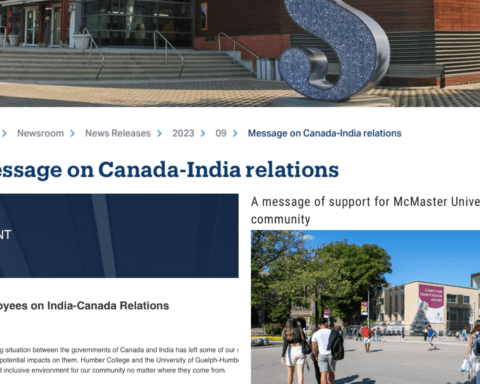Dr. Keiko Yoshioka is a Japanese-born professor of biology at the University of Toronto. Mumbai-born, San Francisco resident Utsav Shah is a software engineer with Dropbox, a Silicon Valley company specializing in large file sharing. Both hold much-coveted degrees in Science Technology Engineering and Mathematics (STEM), both are immigrants to North American countries, have prestigious careers and are extremely happy in their workplaces. However statistically, only one side of the border comes with advantages.
“The major decision was, ‘where will it be easy to find a job after graduation?’” Shah told NCM. He considered the United Kingdom and Canada before settling on getting his education at the University of Illinois Urbana Champaign. He graduated in 2016. His reason for doing so was simple math. “Canada has everything except the salary. I know that if I moved to Canada tomorrow I’m going to see a 40 per cent pay cut.” He generally considers his life in the U.S. a very happy one.
When asked about his salary, he was not comfortable answering. However, the average base salary for software engineers in the U.S. is $107,500. He paid off his student loans, which his parents in India got for him, very quickly and he bought his own house in San Francisco, one of the most expensive housing markets in the country. His success has led him to want to help other immigrants wanting to go to the U.S. “If anybody wants to reach out to me, Twitter DMs are the best to do that. It’s @utsav_sha.” He would like to stay in the U.S. and has applied for his Green Card to that end.
Higher salaries in the U.S.
An April 2019 study published in IZA World of Labor, a research organization specializing in labour, agrees with Shah. The report generally concludes that immigrants holding STEM degrees fare much better in the U.S. than they do in Canada. It listed a number of possible reasons why this is the case. Higher salaries are a major reason why.
“Over the 1980–2005 period, the relative (to the comparable native-born) wages of highly educated recent immigrants followed very different paths in Canada and the US,” read the report. “By 2005, relative entry wages of highly educated immigrants in the U.S. were at about the same level as they were in 1980, but in Canada, they were significantly lower,” it added.
Dr. Yoshioka did stress that Canada can offer a good, happy life for STEM immigrants.
“Salaries in Canada are not low at all,” she said. “Some American universities’ salaries are quite low. In some cases, Canadian university salaries are much higher.”
According to the Sunshine List, an annual disclosure of public sector employees, Yoshioka earned $175,191 in 2019. She received her PhD from Japan’s Hokkaido University in 1994 and has also worked at Rutgers University in New Jersey. She could have gone back to Japan, but there are few jobs there in her field and her husband is not Japanese, meaning an English-speaking country will have to do. “I felt maybe University of Toronto was my first choice university. I was happy when I got a position here.” Her work looks at the immunology of crop plants. She says she may stay in Canada even after retirement.
While she is happy in Canada, she does acknowledge that certain things are better about the American STEM field. “Of course, there are more jobs in the U.S. than Canada. I’m sure. Because the size of the economy is completely different.”
Simply more jobs play a role in Americans having an advantage. Shah’s place of work, Dropbox is located in Silicon Valley. It shares space with industry giants like Facebook, Google (where Shah interned), Hewlett Packard, Adobe, Intel and Cisco, just to name a few, are all household names and some of the largest companies in the world. As a measure of Silicon Valley’s ubiquity, HBO even made a highly popular comedy series of the same name.
Differences in demographics are also listed as a possible factor behind superior outcomes in the U.S. versus Canada. American companies and institutions tend to attract more highly skilled STEM immigrants. “The composition of immigrants is different between the two countries,” Feng Hou of Statistics Canada, one of the authors of the study said. “Those people who are highly motivated and highly skilled, they can get a better job with more pay in the U.S.,” he said bluntly.
Too many STEM immigrants
Canada also has more STEM-educated immigrants, which can be detrimental to them. When there is an overabundance of STEM immigrants, employers tend to hire people with education from universities they are familiar with, squeezing out people with degrees from non-western schools.
Policy differences also contribute. In order to get an American work visa, the H1-B, candidates have to get a job offer first. The visa is conditional upon having a job even when it has already been granted. “If I get fired tomorrow, I get kicked out of the country if I don’t get a job within 60 days,” Shah said.
Concerns of the U.S. having a superior job market is nothing new. Brain drain, the phenomenon of losing workers to American companies has been an anxiety in Canada for several decades. Concerns were especially heightened in 1989 and 1994 when Canada was negotiating major free trade agreements with American counterparts.
Hou and colleague Garnett Picot, in their report, recommend that Canada should have a smaller and better-targeted selection of STEM immigrants because “simply increasing the number of STEM immigrants using the existing selection system is not likely to generate large benefits, as one risks simply getting more of the same.”
Mansoor Tanweer is New Canadian Media’s Local Journalism Initiative reporter on immigration policy. An immigrant himself, he has covered municipal affairs and the Brampton City Council in addition to issues relating to newcomers over several years.





